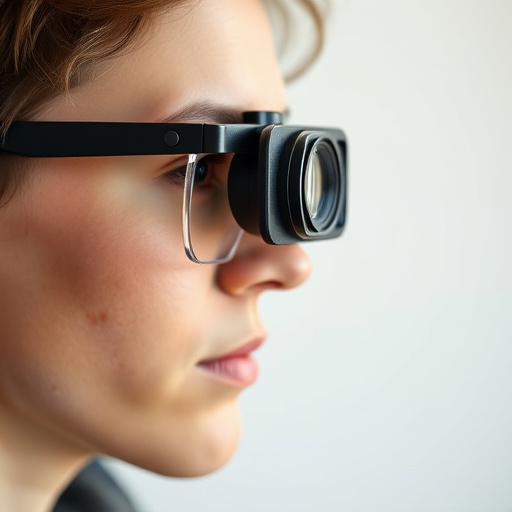Glasses with a camera built-in (smart glasses) are transforming photography by offering hands-free, first-person perspective imaging for various applications. These devices, featuring compact sensors and augmented reality capabilities, enhance daily life, travel, and professional work through accessible content creation. Top brands like Oakley, Ray-Ban, and Gucci offer diverse models with high-definition recording, stable mounts, and easy controls. Future advancements promise improved image quality, privacy protections, and seamless integration into digital lives, making smart glasses a growing trend in technology.
Glasses with a camera built-in, or smart glasses, are transforming how we interact with technology. These innovative devices seamlessly integrate photography and video capture into daily wear, offering hands-free convenience and enhanced vision. This article explores the concept of glasswear with integrated cameras, delving into their functionality, benefits, real-world applications, top models from leading brands, and the future prospects for consumers.
What are Glasses with a Camera Built-In?
Glasses with a camera built-in, often referred to as smart glasses or camera-enabled eyewear, are innovative devices that merge the functionality of traditional spectacles with the photography capabilities of a digital camera. These glasses typically incorporate tiny cameras into their frames, allowing users to capture images and videos hands-free while offering a discreet and unique perspective on their surroundings.
Designed for a range of purposes, from casual social media content creation to professional applications like remote inspections or live streaming, glasses with a camera built-in offer a new way to visualize and interact with the world. With compact sensors, advanced image stabilization, and sometimes even augmented reality features, these smart glasses are transforming how we document and share our experiences, making photography more accessible and integrated into our daily lives.
How Do These Camera Glasses Work?
Camera glasses with a built-in lens and sensor capture video or still images through a small, discreet display. These innovative devices typically use a microcamera hidden within one or both frames of the glasses, allowing for hands-free recording or photography. When activated, the camera captures visual content which can then be reviewed instantly on the integrated display or transferred to a connected device for further editing and sharing.
The simplicity and convenience of these glasses make them ideal for various applications, from capturing travel memories and vlogging to surveillance and security. Their compact size and ability to provide a first-person perspective offer users a unique way to record their experiences, making them a popular choice among tech enthusiasts and content creators alike.
Benefits and Applications of Smart Glasses
Smart glasses equipped with a camera offer a unique blend of technology and convenience, opening up a world of benefits and applications. One of the primary advantages is their ability to capture moments hands-free. Whether it’s taking photos or recording videos, these glasses provide a new perspective, literally, allowing users to document experiences without disrupting their environment. This feature makes them ideal for travel, events, and even daily life, ensuring you never miss a memorable instant.
Additionally, smart glasses with cameras have practical applications in various fields. In professional settings, they can facilitate remote collaboration, enabling workers to project and share their field-of-view with colleagues, enhancing teamwork. They also find use in healthcare, where medical professionals can access patient data and take quick visual notes during examinations. Moreover, these glasses can assist in industrial training by providing real-time instructions, making learning more immersive and efficient.
Top Models and Brands in the Market
The market for glasses with a camera built-in has seen significant growth, driven by advancements in technology and consumer demand for innovative gadgets. Top models from leading brands offer a range of features, from high-definition video recording to advanced photo capabilities. Brands like Oakley, known for their sports eyewear, have integrated cameras into their products, catering to action enthusiasts who want to capture every thrilling moment. For those seeking more stylish options, Ray-Ban and Gucci have introduced sleek designs that blend fashion with functionality, ensuring you look good while capturing memorable moments.
These top brands not only deliver high-quality optics but also prioritize user experience, incorporating stable mounts and easy-to-use controls. The best models often feature waterproof designs, making them suitable for outdoor activities like skiing or surfing. With a wide array of options available, consumers can choose based on their specific needs, whether it’s capturing action-packed adventures or simply documenting everyday life with an added stylish touch.
Future Outlook and Considerations for Users
The future of glasses with a camera built-in looks promising, offering exciting possibilities for both personal and professional use. As technology advances, we can expect to see more sophisticated designs with improved image quality, enhanced privacy features, and longer battery life. These smart glasses will likely integrate seamlessly with our digital lives, allowing for hands-free photography and video recording during everyday activities.
Users should consider factors like field of view, weight, comfort, and data security when choosing glasses with a camera built-in. As these devices become more prevalent, ensuring privacy and data protection will be crucial. Future models might incorporate advanced AI capabilities for object recognition, automatic scene selection, and enhanced augmented reality experiences, further blurring the line between the physical and digital worlds.
